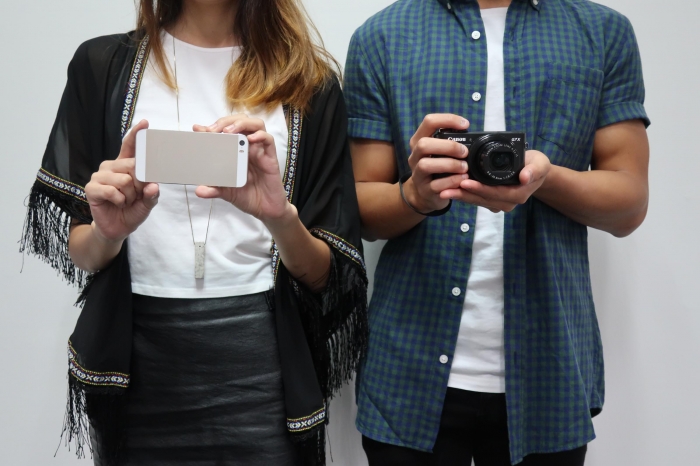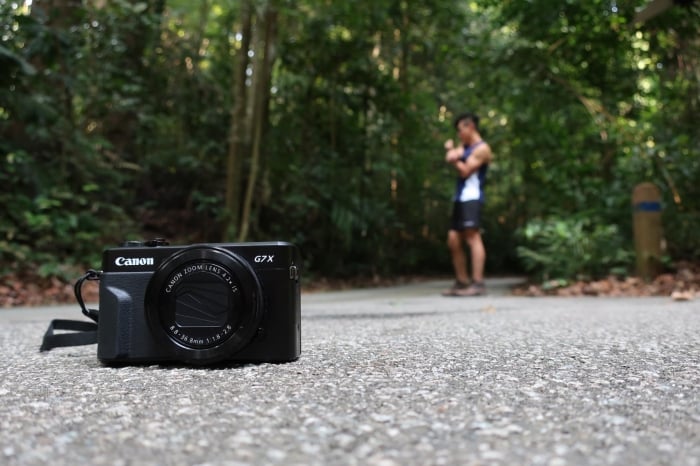Ah, the perennial question – smartphone or camera? In this age where smartphones are seemingly glued to everyone’s hands, having a camera might indeed seem a tad superfluous. After all, gone are the days where phones could only take extremely grainy photos – today’s smartphones can produce pictures of considerable quality!
However, despite how smartphones might have become our very own personal cameras, they still offer inadequate substitutes for actual cameras.

This is especially so during our travels, where actual cameras generally outclass smartphones in many ways! We decided to put this theory to the test and brought both gadgets along on our recent expedition up Gunung Datuk in Malaysia. We pitted the smartphone against the Canon PowerShot G7 X Mark II, and no guesses as to which came out top.
But don’t just take our word for it and see for yourself. With a camera…
1. Your photos will be more vivid
You don’t get the washed-out effect when taking photos with a camera.
The beauty of a photograph is the ability to capture the moment that you were experiencing, thereby allowing you to revisit that moment any time you want. And yet, smartphones often fail to capture the vibrancy of a scene as you see it to be! Fortunately, camera photos tend to reproduce colours better than photos from a smartphone. Just take the above photo as a comparison: for the same scene, the photo taken by the camera is certainly much more vivid.
2. You have better zoom (and the quality of the photo still remains)
You would not have noticed the insects on the flowers if you had taken it with a smartphone.
Everyone knows that photo quality tremendously decreases the more you zoom in with your smartphone camera. At maximum zoom, the photo tends to become so grainy that it’s not worth taking the photo at all! On the other hand, balancing zoom and image quality is not a huge concern when you are using a camera. Almost every camera offers an optical zoom function, allowing you to take clear photos even as you are zooming in on a distant object.
3. Your photos will be sharper
Sharper also means more detail.
Smartphones might already been astounding us with the capability to take crisp photos, but there is still a limit to the image quality that one can get from a smartphone. On the other hand, cameras are not constrained by such perimeters – just look at the amazing resolution of photos from top-tier DSLR cameras! Even taking aside equipment only considered by (and discussed among) professional photographers, a decent digital camera – such as the Canon PowerShot G7 X Mark II – does get you sharp and clear photos that are adequate for you to show off at the annual get-together with the extended family.
4. You can take more artistic shots
Same plant, different story.
For those who love an artistic slant to their photos, the smartphone might prove difficult to obtain certain kinds of shots. Take for example, photos which utilise depth of field. Part of these photos, such as the foreground or background, are usually blurred for effect. The smartphone would attempt to capture every aspect of the photo in clarity, as compared to the camera, which can be easily toggled to focus on a single point instead! If you are looking to bring a message across with your photos, or simply spice up your Instagram repertoire, a camera would be a better choice.
5. Your photos of fast-moving objects will be clearer
The red ball on the left photo is more blurred.
It can get difficult to capture fast-moving objects with smartphones. Most of the time, the photo ends up blurred, especially if the object is moving extremely quickly. Conversely, cameras have modes to capture objects in motion, or settings that can be toggled to the same effect! You can easily take a clear photo of your friends playing football on the beach in France, or vintage cars whizzing down the highway in Cuba. With the camera’s ‘panning’ function, you’ll even be able to take photos of moving objects against a blurred background for that added artistic flair.
6. You can take better photos of animals
It’s the same ant, but look at the vast difference in photo quality!
Photographing animals can get tricky, especially since they tend to move quickly and in blatant disregard of our repeated commands to stay still. If you are already having trouble taking a good photo of the family dog, you might find taking photos of animals in the wild to be extremely challenging! But fret not, having a camera instead of a smartphone does help significantly. From a much better zoom function to available settings for capturing fast-moving objects, a camera is definitely needed to capture wildlife.
7. Your night photos are at least decent even without flash
More details of the spiderweb can be seen with the photo taken by the camera.
One main gripe we all have is that our smartphones are unable to take decent (just simply decent; not even getting to good) photos at night without the use of additional phone apps! Photos taken at night are either indecipherable masses of light, or, when the flash function is used, horrific environments filled with ghastly faces and pale objects. The camera, on the other hand, is versatile enough to capture night scenes even without the use of flash! Simply toggle the appropriate settings, or rely on the generally-dependable “auto” mode to get the photo you need. So say goodbye to nasty night photos – with a camera, your campfire pictures will definitely look that much better!
8. Your photos of the night sky are clearer
The camera is certainly better in terms of zoom length and photo quality.
If being able to take good photos at night is not a convincing reason (though unthinkably so), then the ability to take clear photos of the night sky would certainly be one! Without the use of third party apps, taking photos of a starry sky would be a near-impossible feat for smartphones. Even getting a good picture of the moon can be challenging! And yet, such difficulties are not present when shooting with a camera. The pictures above illustrates it all: both were taken with the iPhone and camera at their respective maximum zooms, and the one on the right clearly wins in terms of quality.
9. It’ll be much easier to take group photos
With the camera and tripod, no one gets left behind.
We all know the hassle when it comes to taking group photos with a smartphone – you simply cannot be in the photo and take the picture at the same time. And we all know the usual solutions: 1) bring a selfie stick, 2) get a stranger to help you, or 3) sacrifice your presence in the photo. Sometimes only the third option is feasible, especially when you are travelling somewhere remote or when you want a full-body shot of everyone.
The camera easily reduces this hassle with two features: the ability to be mounted on a full-length tripod, and an in-built self-timer feature! You can set up the camera at the desired angle, and get into the photo before the timer runs out. Tripods are also lightweight and very portable, making it an easy travel accessory for group trips with friends or family. With a camera and a tripod, make sure you’ll never be left out of a photo again!
From getting more vivid photos to looking better while taking pictures, bringing along a camera for your vacation certainly has its perks! So invest in a good camera before you jump into your next getaway – once you get one, you will never want to take photos with your smartphone again!
 The Canon PowerShot G7 X Mark II.
The Canon PowerShot G7 X Mark II.
All camera comparison photos were taken with the Canon PowerShot G7 X Mark II, which has managed to enchant us with its compact size and amazing zoom. Besides being lightweight and small enough to easily carry around on a mountain hike, the Canon PowerShot G7 X Mark II even had functions that allowed us to capture photos of the elusive mountain wildlife.
Seamlessly transfer photos to your phone on the go with the wireless bluetooth function; yes, now you get higher quality photos for your Instagram, and not grainy haphazard ones shot with the iPhone camera. The Canon PowerShot G7 X Mark II has a wide angle lens and a flip LCD screen, making selfies a whole lot easier to take. Rid your feed of your smartphone’s front camera’s selfies that basically feature most of your face and nothing else. If you are looking for the perfect travel accessory, this camera is the one for you!
So, camera VS smartphone. Is there really any question?
Yep, we didn’t think so.
Brought to you by Canon.




